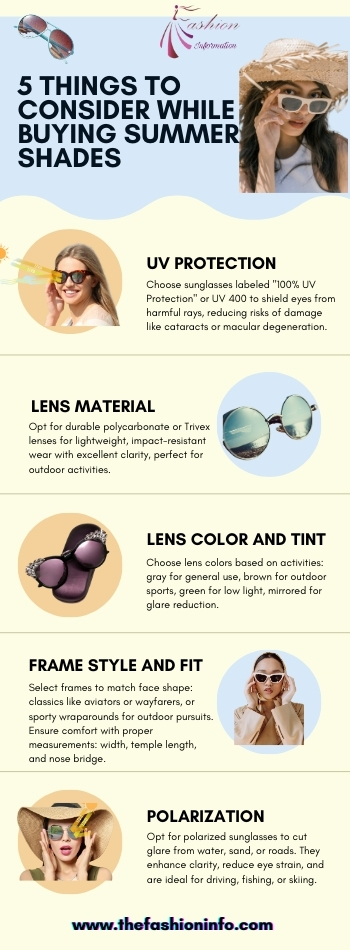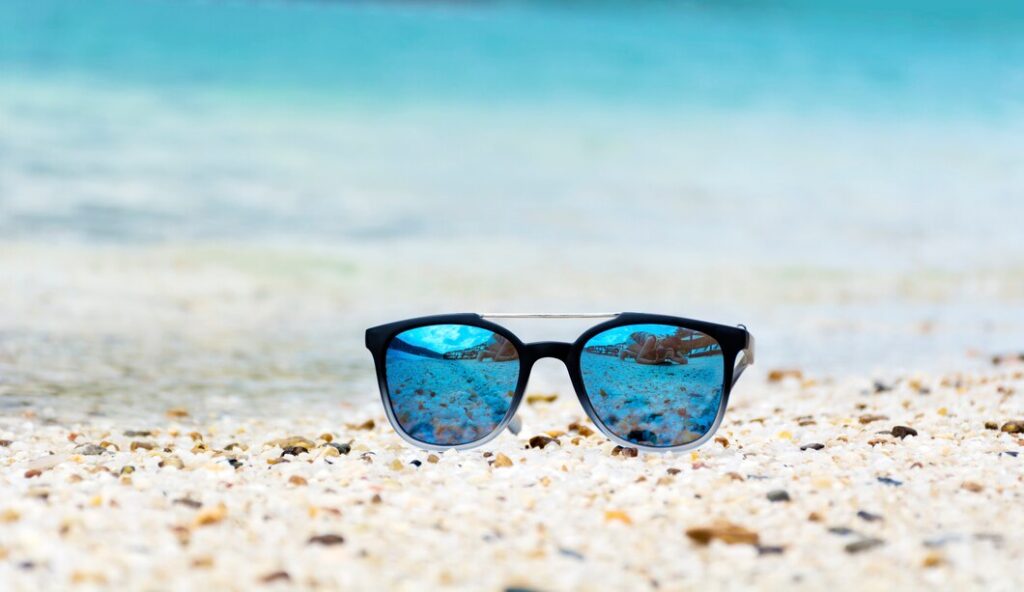Table of Contents
Introduction
Summer is the perfect time to soak up the sun, but it’s essential to protect your eyes from its harmful UV rays. A stylish pair of sunglasses not only adds a touch of flair to your summer wardrobe but also shields your eyes from potential damage. However, buying summer shades can be a bit more complex than you might think. To help you make an informed choice, here are five key things to consider when purchasing your summer sunglasses.
Points to consider while buying summer shades
1. UV Protection is Non-Negotiable:
The primary purpose of sunglasses is to protect your eyes from harmful ultraviolet (UV) rays. When shopping for summer shades, always check for UV protection. Look for sunglasses that provide 100% UVB and UVA protection, or UV 400, which blocks all light rays with wavelengths up to 400 nanometers. This ensures your eyes are shielded from the sun’s harmful effects, reducing the risk of cataracts and other eye conditions.
2. Lens Quality Matters: Buying summer shades
The lens quality of your sunglasses can significantly impact your eye comfort and overall experience. High-quality lenses offer better clarity, reduced distortion, and improved durability. There are various lens materials to choose from, including glass, polycarbonate, and acrylic. Glass lenses provide excellent clarity but can be heavy, while polycarbonate lenses are lightweight and impact-resistant. Consider your lifestyle and activities when choosing the lens material that best suits your needs.
3. Frame Style and Fit:
Selecting a frame style that complements your face shape and personal style is crucial. Different frame shapes suit different face shapes. For instance, square frames work well with round faces, while round or oval frames complement square faces. When trying on sunglasses, ensure they sit comfortably on your nose and ears. They should not pinch or slide down your nose. Additionally, consider the size of the frames in relation to your face; oversized frames can make a bold fashion statement, while smaller frames offer a more understated look.
Also Read: Simple Steps On How To Choose A Decent Ring
4. Lens Color and Tint:
The lens color can affect your vision and the way you perceive colors. Darker lenses reduce brightness and glare but may not be suitable for activities like driving. Gray, brown, and green lenses are versatile choices that maintain color accuracy. Polarized lenses are ideal for reducing glare from surfaces like water and roads. For water sports or outdoor activities, consider mirrored lenses, which provide additional glare reduction.
5. Budget and Brand: Buying summer shades
Set a budget before you start shopping for sunglasses. Quality sunglasses can come at various price points, so knowing your budget helps you narrow down your options. While designer sunglasses can be appealing, there are many reputable brands that offer excellent UV protection, lens quality, and style at more affordable prices. Do some research and read reviews to find brands that offer the best value for your budget.
Infographic: 5 Things to consider while buying summer shades

FAQ
How to choose sunglasses for summer?
Summer is synonymous with sunny days, and while soaking up the sun is fun, protecting your eyes from its harmful rays is equally important. A stylish pair of sunglasses not only adds a touch of flair to your summer wardrobe but also safeguards your eyes from potential damage. Choosing the right sunglasses involves more than just aesthetics.
What are the requirements for sunglasses?
The requirements for sunglasses, especially if you want to ensure their effectiveness in protecting your eyes from harmful UV rays and their overall quality, include the following aspects:
- UV Protection
- Lens Quality
- Lens Color and Tint
- Frame Style and Fit
- Durability
- Compliance with Safety Standards
- Proper Fit and Comfort
- Brand Reputation and Reviews
- Budget
Also Read: Benefits of Eco-Friendly Tote Bags
How do I choose sunglasses for my face?
Choosing sunglasses that complement your face shape is key to finding a pair that not only looks great but also provides a flattering fit. Here are some guidelines to help you select sunglasses that match your face shape:
- Identify Your Face Shape:
- Oval Face
- Round Face
- Square Face
- Heart-Shaped Face
- Diamond Face
- Rectangular Face
- Frame Size and Proportion
- Frame Style
- Try Before You Buy
- Consider Skin Tone
- Face Shape Overrides
Also Read: The traveling checklist – waterproof backpack
What is class 3 sunglasses?
Class 3 sunglasses, also known as Category 3 sunglasses, are a specific type of eyewear designed for sun protection. They are typically labeled as “CAT 3” and are primarily used for moderate to bright sunlight conditions. These sunglasses offer a high level of protection against harmful ultraviolet (UV) rays, making them suitable for a wide range of outdoor activities.
Key characteristics of Class 3 or Category 3 sunglasses include:
- UV Protection
- Light Transmission
- Sunlight Conditions
- Versatility
- Lens Tint

